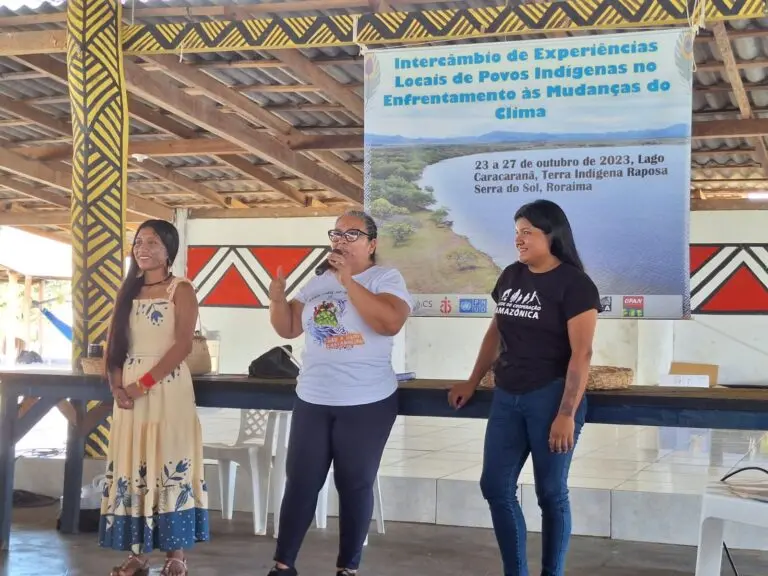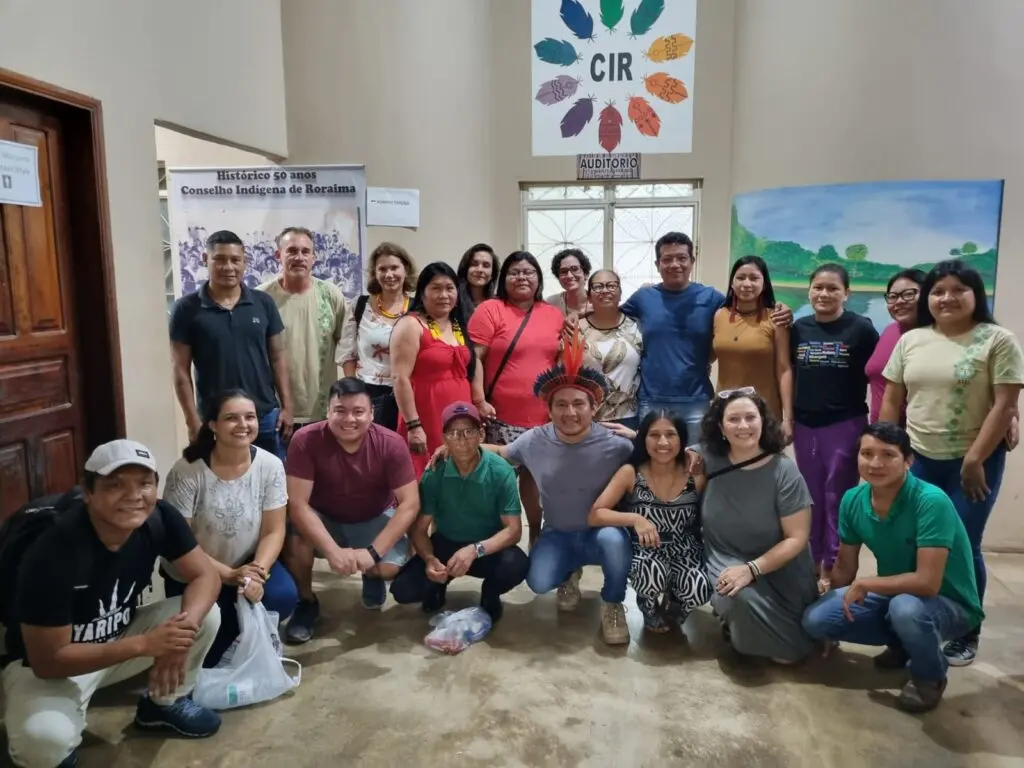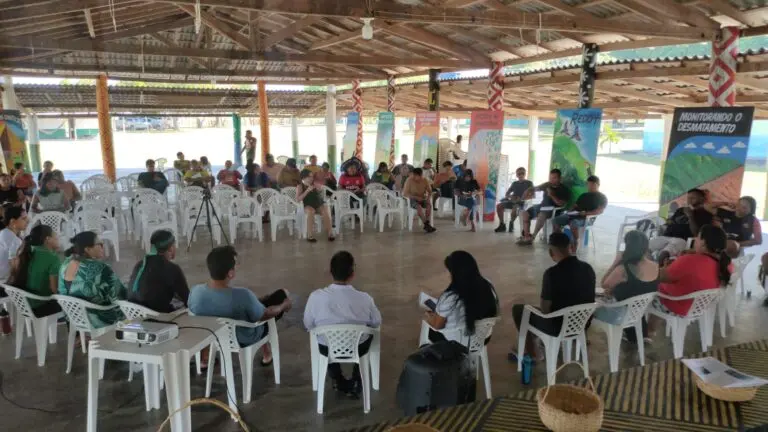Learning from those who know
Exchange of indigenous experiences on the climate shows Roraima pioneering in the technical work of training in the territories for an international quality.
Ti Raposa Serra do Sol, RR – The hot nights by the lake Caracana, in the Raposa Serra do Sol Indigenous Land, made the participants of the “exchange of local experiences of indigenous peoples about climate change” to feel the discomfort of a warmer and unbalanced world. The paradisiacal setting of that little piece of freshwater floor, the exclusive Lavrado Roraimense and the mountains on the border with Guyana was the scene of a meeting organized by the Indigenous Council of Roraima (CIR), the Amazonian Cooperation Network (RCA) and the Operation Native Amazon. (OPAN) With the objective of discussing important issues related to the Climate Agenda, including territorial management and international incidence, this time in a territory symbol of the struggle for the rights of indigenous peoples, whose energy infected those present.
“In this exchange of experiences of the states of the Amazon and in all regions of Roraima, we are dealing with and discussing relevant topics to contribute to a macro coping plan for the entire Amazon, so that we can have an influence on the PNA[Plano Nacional de Adaptação]. We want a plan that we build and not from top to bottom”, explained Sineia do Vale, from the Wapichana people, coordinator of the Department of Territorial and Environmental Management of the CIR and National Coordinator of the Indigenous Committee on Climate Change (CIMC). There is no time to waste. “This is a time of climate crisis and we need to be ready to help our communities”, he warns.

About ten years ago, the CIR published its first plan to combat climate change based on local experiences in the Serra da Lua region, in the eastern portion of the state. In addition to having served as a reference for the elaboration of the indigenous sub-chapter of the first National Adaptation Plan in Brazil – published in 2016 and currently under review – this year the work was First presented in an activity of the Platform of Local Communities and Indigenous Peoples of the Climate Convention, in Bonn, Germany, in June.
Now, in Roraima, it was the turn of the participants to get to know first hand the experiences of building two other plans, those from the Amajari region and those from Raposa Serra do Sol itself, which are being finalized and have not yet been published. These are work done with communities, which must actively participate in these mechanisms to understand and use them. “It is very important that communities are aware of safeguards and their rights, and for that they need to have access to this information with simple language and respecting their way of life”, highlights Sineia.
At the meeting, in addition to the leaders of different ethnoenvironmental regions of Roraima that make up the CIR, each indigenous representative was invited to share their experience, actions and reflections on climate change. In addition to the CIR, who hosted the RCA, the Association of the Indigenous Land of the Xingu (Atix), the Federation of Indigenous Organizations of the Rio Negro (FOIRN), the General Organization of the Mayoruna (OGM), the Association of the Movement of Indigenous Agroforestry Agents participated by the RCA. From Acre (Amaaiac), the organization of the indigenous teachers of Acre (OPIAC) and the Juruena Network Vivo with representatives of the Rikbaktsa, Manoki and Kawaiwete peoples.

For Patrícia Zuppi, deputy executive secretary of the RCA, the change in the methodology of training on climate incidence and its displacement to a territory context intended to value the exchange between indigenous leaders, strengthening the strategies for the incidence of indigenous peoples in the climate agenda. “We have always had preparatory meetings before the international agenda and we seek to map the context of the Climate Convention, its spaces, ways of functioning and opportunities for the participation of indigenous peoples, understanding what are the priority themes of interest to the communities. Based on this understanding and this mapping, we believe that indigenous representatives can better prepare themselves to bring their voices and perspectives to these spaces. We have been doing this for a few years, always in articulation with the indigenous movement. Now, training in an indigenous territory, an old desire of the leaders, sought to root these conversations further, better contemplating the experiences, initiatives and demands from the territories”, he detailed.
Learnings for the Juruena Vivo Network
The pioneering spirit of the CIR in the climate agenda could be understood within its history of political formation of the indigenous movement for more than five decades. The experience of former leaders present at the meeting, added to the powerful and engaged speeches of the young people, not only concretely represented the meaning of the exchange, but impressed the participants of the Juruena Vivo Network at the meeting.
“Their organization[CIR]It’s very strong. We can take as an experience for our community the involvement of young people, so that they can acquire this knowledge, showing that they have the ability to help in the organization of the people, as we saw in Roraima. Climate change is a new learning experience. It is very important to go over it”, commented Givanildo Bismy, from the Rikbaktsa people. As pointed out by Dineva Kayabi, deputy treasurer of the Coordination of the Indigenous Organizations of the Brazilian Amazon (Coiab), representative of the Kawaiwete people and a member of the Juruena Vivo Network, it is beautiful to see how young people participate and face responsibility. “Every time I come here I strengthen myself, I take this youth as a reference. It’s my pride,” he said.
author test
“We learn a lot when we come to this place and know the experience of the struggle of the indigenous movement in Roraima from their own perspective. It was inspiring. We live in a region where everyone is feeling climate change, but it is difficult to connect this with national and international discussions because they are complex, full of acronyms. We have a challenge to value the perspective of those who are in the place, the knowledge and carry the message of the communities forward, transforming this into public policy and concrete actions”, evaluated Liliane Xavier, an indigenist at Opan.

Tipupici Manoki, who has already represented the Juruena Vivo network nationally and internationally, highlighted the importance of women such as Telma Taurepang and Sineia do Vale, who were by their side, in the process of political formation in the fight for rights and for incidence in the climate when the indigenous people who have already They had gone to a climate conference were invited to share their experience. “It is very true when Telma says that universities do not teach us to be in these spaces because they are politicians. What I learned was during my life in the movement. I didn’t plan it. I have always fought for my people and my territory and the consequences of my actions took me to the COP, in Katowice, Poland, in 2018, then to Berlin, in 2019 and now here”, he reported.
Tipuici also spoke about the importance of studying and preparing for a performance abroad, especially in the climate issue. “We participated in local, state training, then in Brasília when we went to the COP. The formations make us understand these spaces, but our ability to speak in a short time and with the key words, in their language, depends on how much we are involved with our territories”, he pointed out.

“We are once again doing training. Soon we will have our Juruena Vivo Festival and we already have a table to talk about the weather. I really want to thank Sineia and I’m hoping to make our coping plan. I am proud to say that we made our consultation protocol after these incidents. With the CIR materials and all this baggage of knowledge, we will mature even more. We need to take all this and apply it in our territory. This is our role,” Tipuici concluded.
Since 2020, OPAN and RCA have been partners in training initiatives on climate and processes of international incidence with indigenous peoples.
